Manjie Xu
Hearing from Silence: Reasoning Audio Descriptions from Silent Videos via Vision-Language Model
May 19, 2025Abstract:Humans can intuitively infer sounds from silent videos, but whether multimodal large language models can perform modal-mismatch reasoning without accessing target modalities remains relatively unexplored. Current text-assisted-video-to-audio (VT2A) methods excel in video foley tasks but struggle to acquire audio descriptions during inference. We introduce the task of Reasoning Audio Descriptions from Silent Videos (SVAD) to address this challenge and investigate vision-language models' (VLMs) capabilities on this task. To further enhance the VLMs' reasoning capacity for the SVAD task, we construct a CoT-AudioCaps dataset and propose a Chain-of-Thought-based supervised fine-tuning strategy. Experiments on SVAD and subsequent VT2A tasks demonstrate our method's effectiveness in two key aspects: significantly improving VLMs' modal-mismatch reasoning for SVAD and effectively addressing the challenge of acquiring audio descriptions during VT2A inference.
Learning to Plan with Personalized Preferences
Feb 02, 2025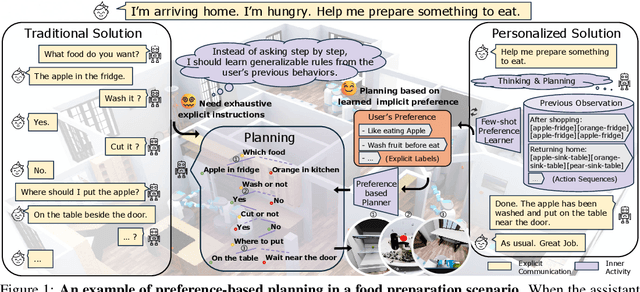

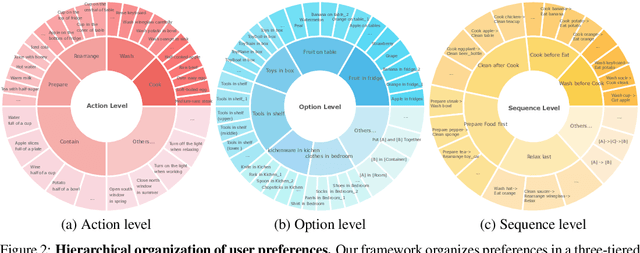

Abstract:Effective integration of AI agents into daily life requires them to understand and adapt to individual human preferences, particularly in collaborative roles. Although recent studies on embodied intelligence have advanced significantly, they typically adopt generalized approaches that overlook personal preferences in planning. We address this limitation by developing agents that not only learn preferences from few demonstrations but also learn to adapt their planning strategies based on these preferences. Our research leverages the observation that preferences, though implicitly expressed through minimal demonstrations, can generalize across diverse planning scenarios. To systematically evaluate this hypothesis, we introduce Preference-based Planning (PbP) benchmark, an embodied benchmark featuring hundreds of diverse preferences spanning from atomic actions to complex sequences. Our evaluation of SOTA methods reveals that while symbol-based approaches show promise in scalability, significant challenges remain in learning to generate and execute plans that satisfy personalized preferences. We further demonstrate that incorporating learned preferences as intermediate representations in planning significantly improves the agent's ability to construct personalized plans. These findings establish preferences as a valuable abstraction layer for adaptive planning, opening new directions for research in preference-guided plan generation and execution.
SRC-gAudio: Sampling-Rate-Controlled Audio Generation
Oct 09, 2024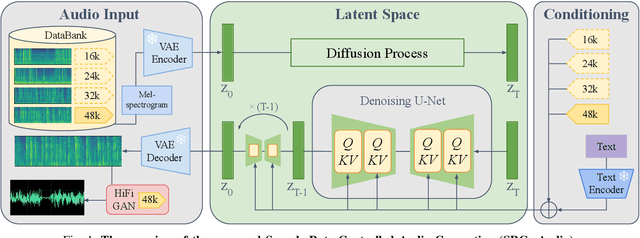
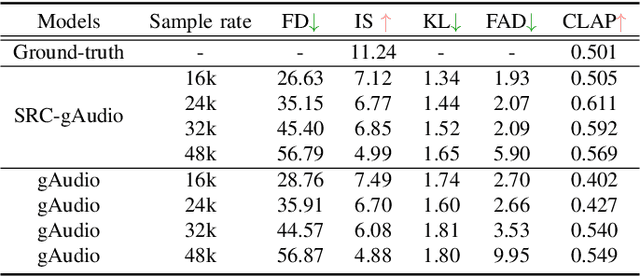
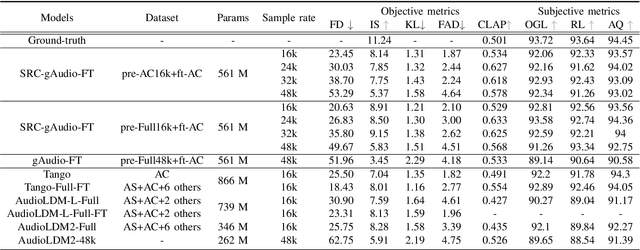
Abstract:We introduce SRC-gAudio, a novel audio generation model designed to facilitate text-to-audio generation across a wide range of sampling rates within a single model architecture. SRC-gAudio incorporates the sampling rate as part of the generation condition to guide the diffusion-based audio generation process. Our model enables the generation of audio at multiple sampling rates with a single unified model. Furthermore, we explore the potential benefits of large-scale, low-sampling-rate data in enhancing the generation quality of high-sampling-rate audio. Through extensive experiments, we demonstrate that SRC-gAudio effectively generates audio under controlled sampling rates. Additionally, our results indicate that pre-training on low-sampling-rate data can lead to significant improvements in audio quality across various metrics.
Towards Diverse and Efficient Audio Captioning via Diffusion Models
Sep 14, 2024Abstract:We introduce Diffusion-based Audio Captioning (DAC), a non-autoregressive diffusion model tailored for diverse and efficient audio captioning. Although existing captioning models relying on language backbones have achieved remarkable success in various captioning tasks, their insufficient performance in terms of generation speed and diversity impede progress in audio understanding and multimedia applications. Our diffusion-based framework offers unique advantages stemming from its inherent stochasticity and holistic context modeling in captioning. Through rigorous evaluation, we demonstrate that DAC not only achieves SOTA performance levels compared to existing benchmarks in the caption quality, but also significantly outperforms them in terms of generation speed and diversity. The success of DAC illustrates that text generation can also be seamlessly integrated with audio and visual generation tasks using a diffusion backbone, paving the way for a unified, audio-related generative model across different modalities.
STA-V2A: Video-to-Audio Generation with Semantic and Temporal Alignment
Sep 13, 2024
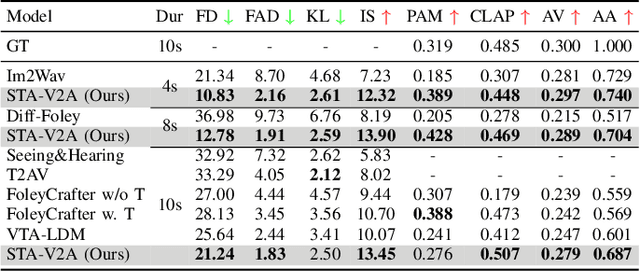


Abstract:Visual and auditory perception are two crucial ways humans experience the world. Text-to-video generation has made remarkable progress over the past year, but the absence of harmonious audio in generated video limits its broader applications. In this paper, we propose Semantic and Temporal Aligned Video-to-Audio (STA-V2A), an approach that enhances audio generation from videos by extracting both local temporal and global semantic video features and combining these refined video features with text as cross-modal guidance. To address the issue of information redundancy in videos, we propose an onset prediction pretext task for local temporal feature extraction and an attentive pooling module for global semantic feature extraction. To supplement the insufficient semantic information in videos, we propose a Latent Diffusion Model with Text-to-Audio priors initialization and cross-modal guidance. We also introduce Audio-Audio Align, a new metric to assess audio-temporal alignment. Subjective and objective metrics demonstrate that our method surpasses existing Video-to-Audio models in generating audio with better quality, semantic consistency, and temporal alignment. The ablation experiment validated the effectiveness of each module. Audio samples are available at https://y-ren16.github.io/STAV2A.
Video-to-Audio Generation with Hidden Alignment
Jul 10, 2024



Abstract:Generating semantically and temporally aligned audio content in accordance with video input has become a focal point for researchers, particularly following the remarkable breakthrough in text-to-video generation. In this work, we aim to offer insights into the video-to-audio generation paradigm, focusing on three crucial aspects: vision encoders, auxiliary embeddings, and data augmentation techniques. Beginning with a foundational model VTA-LDM built on a simple yet surprisingly effective intuition, we explore various vision encoders and auxiliary embeddings through ablation studies. Employing a comprehensive evaluation pipeline that emphasizes generation quality and video-audio synchronization alignment, we demonstrate that our model exhibits state-of-the-art video-to-audio generation capabilities. Furthermore, we provide critical insights into the impact of different data augmentation methods on enhancing the generation framework's overall capacity. We showcase possibilities to advance the challenge of generating synchronized audio from semantic and temporal perspectives. We hope these insights will serve as a stepping stone toward developing more realistic and accurate audio-visual generation models.
Active Reasoning in an Open-World Environment
Nov 03, 2023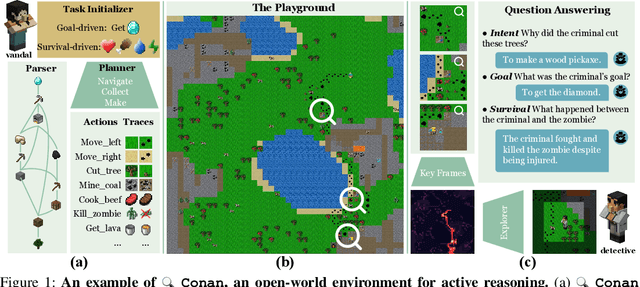

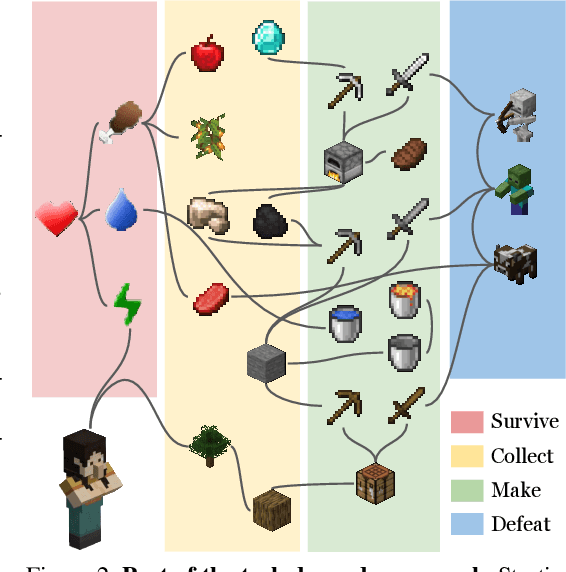
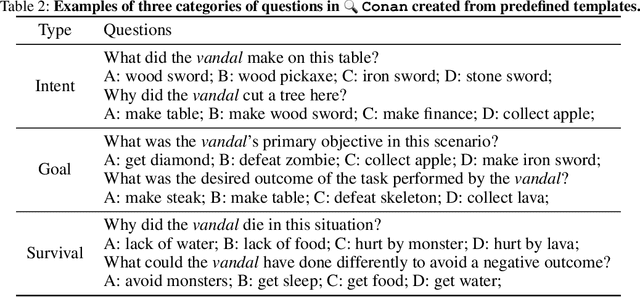
Abstract:Recent advances in vision-language learning have achieved notable success on complete-information question-answering datasets through the integration of extensive world knowledge. Yet, most models operate passively, responding to questions based on pre-stored knowledge. In stark contrast, humans possess the ability to actively explore, accumulate, and reason using both newfound and existing information to tackle incomplete-information questions. In response to this gap, we introduce $Conan$, an interactive open-world environment devised for the assessment of active reasoning. $Conan$ facilitates active exploration and promotes multi-round abductive inference, reminiscent of rich, open-world settings like Minecraft. Diverging from previous works that lean primarily on single-round deduction via instruction following, $Conan$ compels agents to actively interact with their surroundings, amalgamating new evidence with prior knowledge to elucidate events from incomplete observations. Our analysis on $Conan$ underscores the shortcomings of contemporary state-of-the-art models in active exploration and understanding complex scenarios. Additionally, we explore Abduction from Deduction, where agents harness Bayesian rules to recast the challenge of abduction as a deductive process. Through $Conan$, we aim to galvanize advancements in active reasoning and set the stage for the next generation of artificial intelligence agents adept at dynamically engaging in environments.
MEWL: Few-shot multimodal word learning with referential uncertainty
Jun 01, 2023

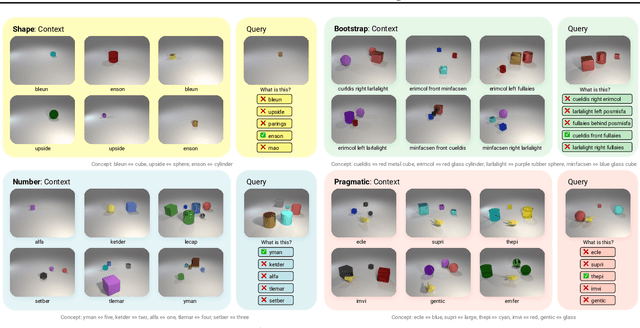

Abstract:Without explicit feedback, humans can rapidly learn the meaning of words. Children can acquire a new word after just a few passive exposures, a process known as fast mapping. This word learning capability is believed to be the most fundamental building block of multimodal understanding and reasoning. Despite recent advancements in multimodal learning, a systematic and rigorous evaluation is still missing for human-like word learning in machines. To fill in this gap, we introduce the MachinE Word Learning (MEWL) benchmark to assess how machines learn word meaning in grounded visual scenes. MEWL covers human's core cognitive toolkits in word learning: cross-situational reasoning, bootstrapping, and pragmatic learning. Specifically, MEWL is a few-shot benchmark suite consisting of nine tasks for probing various word learning capabilities. These tasks are carefully designed to be aligned with the children's core abilities in word learning and echo the theories in the developmental literature. By evaluating multimodal and unimodal agents' performance with a comparative analysis of human performance, we notice a sharp divergence in human and machine word learning. We further discuss these differences between humans and machines and call for human-like few-shot word learning in machines.
To think inside the box, or to think out of the box? Scientific discovery via the reciprocation of insights and concepts
Dec 04, 2022

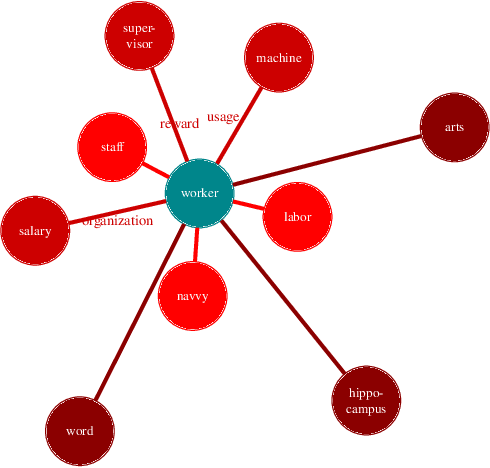

Abstract:If scientific discovery is one of the main driving forces of human progress, insight is the fuel for the engine, which has long attracted behavior-level research to understand and model its underlying cognitive process. However, current tasks that abstract scientific discovery mostly focus on the emergence of insight, ignoring the special role played by domain knowledge. In this concept paper, we view scientific discovery as an interplay between $thinking \ out \ of \ the \ box$ that actively seeks insightful solutions and $thinking \ inside \ the \ box$ that generalizes on conceptual domain knowledge to keep correct. Accordingly, we propose Mindle, a semantic searching game that triggers scientific-discovery-like thinking spontaneously, as infrastructure for exploring scientific discovery on a large scale. On this basis, the meta-strategies for insights and the usage of concepts can be investigated reciprocally. In the pilot studies, several interesting observations inspire elaborated hypotheses on meta-strategies, context, and individual diversity for further investigations.
On the Complexity of Bayesian Generalization
Nov 26, 2022



Abstract:We consider concept generalization at a large scale in the diverse and natural visual spectrum. Established computational modes (i.e., rule-based or similarity-based) are primarily studied isolated and focus on confined and abstract problem spaces. In this work, we study these two modes when the problem space scales up, and the $complexity$ of concepts becomes diverse. Specifically, at the $representational \ level$, we seek to answer how the complexity varies when a visual concept is mapped to the representation space. Prior psychology literature has shown that two types of complexities (i.e., subjective complexity and visual complexity) (Griffiths and Tenenbaum, 2003) build an inverted-U relation (Donderi, 2006; Sun and Firestone, 2021). Leveraging Representativeness of Attribute (RoA), we computationally confirm the following observation: Models use attributes with high RoA to describe visual concepts, and the description length falls in an inverted-U relation with the increment in visual complexity. At the $computational \ level$, we aim to answer how the complexity of representation affects the shift between the rule- and similarity-based generalization. We hypothesize that category-conditioned visual modeling estimates the co-occurrence frequency between visual and categorical attributes, thus potentially serving as the prior for the natural visual world. Experimental results show that representations with relatively high subjective complexity outperform those with relatively low subjective complexity in the rule-based generalization, while the trend is the opposite in the similarity-based generalization.
 Add to Chrome
Add to Chrome Add to Firefox
Add to Firefox Add to Edge
Add to Edge